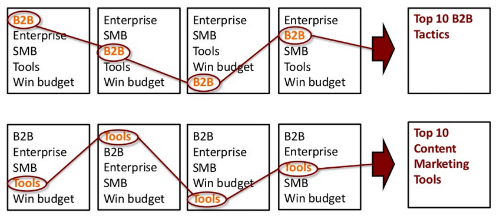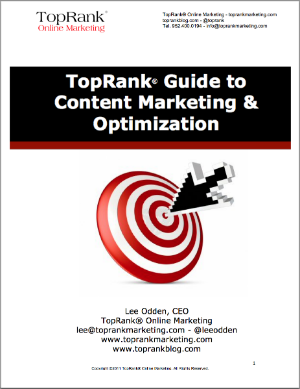 Imagine this: you’re a marketing manager tasked with increasing sales through digital channels. Your customer segments vary from VPs to mid-level managers. You have minimal resources for content creation and social media, but management expects a 30 percent increase in traffic and leads each quarter.
Imagine this: you’re a marketing manager tasked with increasing sales through digital channels. Your customer segments vary from VPs to mid-level managers. You have minimal resources for content creation and social media, but management expects a 30 percent increase in traffic and leads each quarter.
Doing more with less is the “MO” for most marketing departments, and with the increasing complexity of the search, social, and mobile web, many marketers are challenged to be efficient and effective.
The Solution Comes Down to Planning
When there are minimal resources and a demand for performance, there is no substitute for getting creative and being as efficient as possible. Smart planning enables high-performing implementation and scale. An editorial calendar is the ideal way to do that planning.
One way to achieve that efficiency and feed the social media and content beast is to organize content creation and promotion by considering the different types of content. Of course there’s a prerequisite to audit existing content and social media assets for an inventory of resources. Then you’d organize those assets according to their alignment with your editorial plan.
Guided by an understanding of organizational goals, unique selling propositions, and insight into the customer journey for each segment’s sales cycle, a content marketing strategy could factor these four types of content to help you create a killer content marketing plan.
Content Repurposing
A lot of content marketing plans start with original content creation, but it’s just more practical to inventory existing digital assets, content objects, and media first. Most companies are not that well organized with their content, and when viewed through a content marketing opportunist’s lens, it’s usually not hard to find many ways to repurpose existing content resources.

Reusing content provides efficiency benefits, but if there are performance metrics, the data can reveal insights to make repurposing even more effective.
Recently we conducted a series of interviews with industry thought leaders in a particular market segment important to our digital marketing agency. The questions included target search keywords and were designed to inspire practical answers to include actionable tips and advice.
After the original interviews were published and promoted through agency social channels and those of the industry thought leaders, the next step for repurposing the interviews involved taking the topically similar questions and answers from different people and aggregating them into a new content object like an ebook, long-form article, infographic, or blog post.
Following a format of “10 Brands (or Thought Leaders) Share Their Top Tips on Topic XYZ” the repurposed content would be unique in that it would not have existed together before. Insights from a few additional thought leaders could be added outside of the initial interview set for flavor.
A heads-up email to interviewees and your community could encourage social sharing, giving your initial content effort additional reach, hang time, and scale without additional resources.
Content Co-Creation
Another layer in your content plan that enables efficient and high-value content creation is to partner with others for creation. One might argue that conducting interviews like the example above is a form of co-creation.
Another co-creation example would be to reach out to clients, partners, employees, industry thought leaders, or even your brand’s social media community to participate in the creation of a new, remarkable content object.
A good example of this would be to work with clients to tell stories of successful or innovative use with your product or service. After collecting the client stories and advice in a way that’s easy for them to share, an ebook or guide could be created that aggregates the advice of multiple people into one resource.
The contributions or co-creation of the content invests participants in the success of the content object. Individual quotes from the client advice could be used to create tweets, images for Pinterest, and Facebook and LinkedIn updates for promoting the end product.
Along the lines of “Facts Tell, Stories Sell,” this kind of content object that’s co-created with clients about use of a product/service leverages a voice of the customer approach to provide useful information to inspire inquiries and social sharing.
Evergreen Content
The creation of original content that remains relevant over time is one of the toughest parts of online marketing. However, it’s essential for creating marketable assets that convey the key messages designed specifically to attract, engage, and convert new business. A layer of evergreen content can work in concert with your other content efforts on a less frequent basis. In fact, evergreen content can serve as a leader for a topic during a cycle of time with other types of content to support it.

One evergreen article per month supported by one to two co-created projects and the same number of repurposed content objects can provide a healthy footprint with a modest investment in time and resources.
Content Curation
Collecting interesting content on a regular basis and organizing it in a useful way can be a very efficient method for providing value with efficiency. Adding your own insight to curated content takes a little more time, but a lot less than creating new content or co-creation and repurposing projects. The weekly news posts we publish are an example of this:
As with the other layers of content above, curated content can follow target topics of importance to your prospects during the sales funnel experience. The usefulness of collecting interesting and timely news, blog posts, and other resources provides community-building benefits and associates your brand as an authority on the topics being curated.
When a content marketing and social media promotion plan is architected using these four types of content, companies can achieve big results with modest resources. The key is to leverage customer insight to create an editorial calendar, smart planning/coordination, and creative execution.
A version of this post originally appeared in my Social Media Smarts column on ClickZ.
MMA Image Credit: Shutterstock




